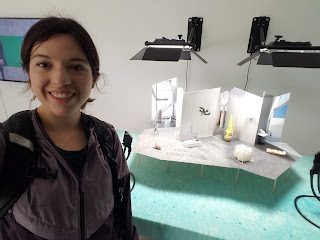Event Blog 3: The Postgenomic Condition
When scientists study genetics, are they just studying genomes, or is something else at play that challenges our established justice system? These are the questions that Dr. Jenny Reardon, a professor of sociology, studies. In her recent talk at UCLA, she explains that much of the data obtained through the Human Genome Project consists mostly of DNA from European descent, yet forming a project that would diversify this pool results in controversy because of potential implications.
Some scientists and laymen claim that race has an impact on genes, whereas others believe it does not. To Dr. Reardon, the solution is not through popular "talk," but through effective, artistic "speech." She says that there is a respectful way to discuss these controversies: to make time, bond with different people, offer a listening ear, and logically present one's ideas to the other party. Jenny's own respect for art in her studies is evident in the way she values proper speech, chooses to listen, and appreciates art as shown on the cover of her novel below.
This event's discussion reminded me of other biotech controversies covered throughout DESMA 9 course lectures, such as the fluorescent albino bunny, Orlan's public plastic surgery performances, and Stelarc's implementation of a third ear (Vesna). Despite the fact that many artists and scientists have tried to expand biological capacity and knowledge, those such as Jenny have decided to explore deeper implications before admitting acceptance; a truly mature response to the art of biology. I agree with Jenny that these explorations in science must be discussed appropriately first. An example of this can be found in the article, "Do Races Differ? Not Really, Genes Show," where several scientists state that human genes have differentiated only in superficial ways from race to race (Angier). This supports Reardon's view of the need for speech before making the assumption that the difference between races can be found in one's DNA.
Sources
Angier, Natalie. “Do Races Differ? Not Really, Genes Show.” The New York Times, The New York Times, 22 Aug. 2000, www.nytimes.com/2000/08/22/science/do-races-differ-not-really-genes-show.html.
Reich, David. “How Genetics Is Changing Our Understanding of 'Race'.” The New York Times, The New York Times, 23 Mar. 2018, www.nytimes.com/2018/03/23/opinion/sunday/genetics-race.html.
“The Postgenomic Condition: Justice, Knowledge, Life After the Genome.” The UCLA Institute for Society and Genetics, socgen.ucla.edu/events/the-postgenomic-condition-justice-knowledge-life-after-the-genome/.
 |
| Photo of Jenny Reardon and Me after the Event |
Some scientists and laymen claim that race has an impact on genes, whereas others believe it does not. To Dr. Reardon, the solution is not through popular "talk," but through effective, artistic "speech." She says that there is a respectful way to discuss these controversies: to make time, bond with different people, offer a listening ear, and logically present one's ideas to the other party. Jenny's own respect for art in her studies is evident in the way she values proper speech, chooses to listen, and appreciates art as shown on the cover of her novel below.
| Dr. Reardon's Novel Presented at the Event |
This event's discussion reminded me of other biotech controversies covered throughout DESMA 9 course lectures, such as the fluorescent albino bunny, Orlan's public plastic surgery performances, and Stelarc's implementation of a third ear (Vesna). Despite the fact that many artists and scientists have tried to expand biological capacity and knowledge, those such as Jenny have decided to explore deeper implications before admitting acceptance; a truly mature response to the art of biology. I agree with Jenny that these explorations in science must be discussed appropriately first. An example of this can be found in the article, "Do Races Differ? Not Really, Genes Show," where several scientists state that human genes have differentiated only in superficial ways from race to race (Angier). This supports Reardon's view of the need for speech before making the assumption that the difference between races can be found in one's DNA.
 |
| Race and Genetics Artistic Rendition, as shown in Reardon's Event (Reich) |
Sources
Angier, Natalie. “Do Races Differ? Not Really, Genes Show.” The New York Times, The New York Times, 22 Aug. 2000, www.nytimes.com/2000/08/22/science/do-races-differ-not-really-genes-show.html.
Reich, David. “How Genetics Is Changing Our Understanding of 'Race'.” The New York Times, The New York Times, 23 Mar. 2018, www.nytimes.com/2018/03/23/opinion/sunday/genetics-race.html.
“The Postgenomic Condition: Justice, Knowledge, Life After the Genome.” The UCLA Institute for Society and Genetics, socgen.ucla.edu/events/the-postgenomic-condition-justice-knowledge-life-after-the-genome/.
“The Postgenomic Condition.” University of Chicago Press, 1 Dec. 2017, press.uchicago.edu/ucp/books/book/chicago/P/bo22726485.html.
Vesna, Victoria. “BioTech + Art.” Lecture 1. <https://cole2.uconline.edu/courses/888567/pages/unit-6-view?module_item_id=16300814>.
Vesna, Victoria. “BioTech + Art.” Lecture 4. <https://cole2.uconline.edu/courses/888567/pages/unit-6-view?module_item_id=16300814>.

Is this for a class?
ReplyDeleteYup!
Delete